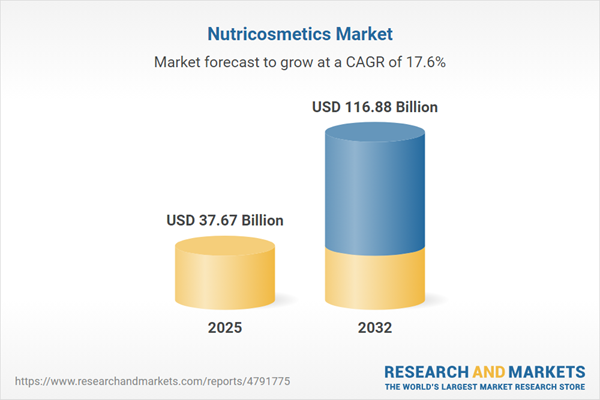Speak directly to the analyst to clarify any post sales queries you may have.
The nutricosmetics market is transforming as proactive wellness becomes central to consumer lifestyles and senior leaders accelerate innovation at the intersection of nutrition and personal care. Companies are adjusting to evolving digital and scientific landscapes that continue to reshape opportunities for competitive advantage.
Market Snapshot: Nutricosmetics Market Size and Growth Outlook
In 2024, the nutricosmetics market was valued globally at USD 31.98 billion and is expected to grow to USD 37.67 billion by 2025, reaching USD 116.88 billion by 2032. This reflects a robust CAGR of 17.58%, underscoring the sector’s sustained momentum. Growth is driven by strong demand for scientifically validated products that blend nutritional and cosmetic technologies. Both established brands and startups are expanding investments in digital platforms and regional development, while leaders focus on holistic strategies to strengthen their presence in the evolving wellbeing sector.
Scope & Segmentation
This comprehensive report empowers executive teams to strategically navigate the nutricosmetics market and pinpoint lucrative segments. Analysis spans critical value drivers and geographic regions to inform targeted strategy development:
- Product Types: Addresses cognitive health, hair care, nail care, skin care, and weight management, enabling organizations to take a holistic approach across the wellness spectrum.
- Formulation Formats: Covers gummies, liquids, powders, softgels, and tablets to support delivery innovations that enhance consumer compliance and experience.
- Applications: Includes anti-aging, cognitive function, detoxification, immune health, and weight control, reflecting the shift toward personalized and preventive care solutions.
- Distribution Channels: Spans retail, health outlets, specialty stores, supermarkets, company websites, and e-commerce platforms, providing multi-channel reach and adaptability.
- Regional Coverage: Examines the Americas (US, Canada, Latin America), Europe, Middle East & Africa (selected high-growth markets), and Asia-Pacific (established and emerging nations) for regional strategy insights.
- Key Industry Players: Highlights leaders such as Koninklijke DSM N.V., Givaudan S.A., Lonza Group AG, Kerry Group plc, Cargill, Glanbia plc, Roquette Frères, Amway, GliSODin Skin Nutrients, and Herbalife Nutrition Ltd., illustrating how partnerships and innovation shape long-term leadership.
Key Takeaways
- Personalized nutricosmetic offerings are expanding as brands combine consumer health data and genomics for tailored solutions, driving deeper client engagement.
- Ongoing ingredient and technology innovation accelerates product cycles and differentiation, with companies leveraging new bioactive compounds and advanced delivery formats.
- Multi-sourcing and local processing are increasingly prioritized, supporting supply chain resilience and operational continuity against external disruptions.
- Sustainability efforts now include greater adoption of recycled materials and eco-conscious packaging, bolstering brand reputation and meeting evolving compliance expectations.
- Digital strategy is fundamental, with brands harnessing analytics and an omnichannel presence to extend market reach and build loyalty across diverse markets.
- Engagement in wellness partnerships and collaborations with specialist distributors is opening new B2B avenues, including professional and clinical applications.
Tariff Impact: Navigating Supply Chain and Pricing Shifts
The implementation of new US import tariffs in 2025 prompted leading nutricosmetics firms to adjust sourcing and operational models. By broadening domestic procurement and scaling local processing, companies increased supply chain oversight and navigated regulatory changes, strengthening stability throughout manufacturing and distribution channels.
Methodology & Data Sources
The research integrates thorough secondary reviews, executive interviews, and advanced quantitative analysis. Data sources include industry publications, regulatory documents, proprietary research processes, and global trade statistics, ensuring decision-level accuracy.
Why This Nutricosmetics Market Report Matters
- Provides actionable intelligence for directing innovation, product alignment, and regulatory navigation in an evolving sector.
- Enables leaders to optimize portfolios and market expansion, adjusting to shifting consumer preferences and the competitive landscape.
- Supplies risk-managed insights for adaptive supply chain planning and strategic investment decisions.
Conclusion
Senior decision-makers benefit from concise, evidence-based insights to lead effectively in the fast-changing nutricosmetics landscape. This report supports agile strategy and builds confidence for leadership as industry transformation continues.
Additional Product Information:
- Purchase of this report includes 1 year online access with quarterly updates.
- This report can be updated on request. Please contact our Customer Experience team using the Ask a Question widget on our website.
Table of Contents
3. Executive Summary
4. Market Overview
7. Cumulative Impact of Artificial Intelligence 2025
Companies Mentioned
The companies profiled in this Nutricosmetics market report include:- Koninklijke DSM N.V.
- Givaudan S.A.
- Lonza Group AG
- Kerry Group plc
- Cargill, Incorporated
- Glanbia plc
- Roquette Frères
- Amway Corporation
- GliSODin Skin Nutrients
- Herbalife Nutrition Ltd.
Table Information
| Report Attribute | Details |
|---|---|
| No. of Pages | 190 |
| Published | October 2025 |
| Forecast Period | 2025 - 2032 |
| Estimated Market Value ( USD | $ 37.67 Billion |
| Forecasted Market Value ( USD | $ 116.88 Billion |
| Compound Annual Growth Rate | 17.5% |
| Regions Covered | Global |
| No. of Companies Mentioned | 11 |









